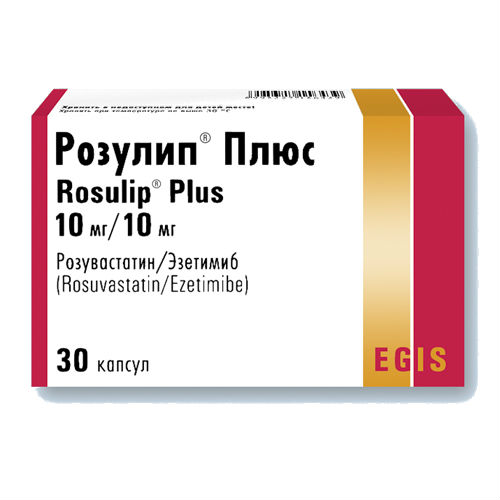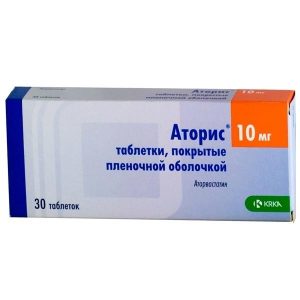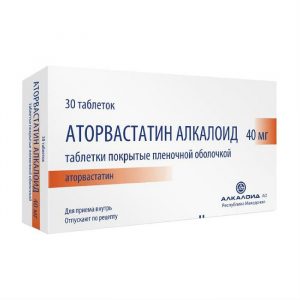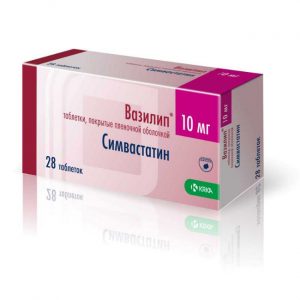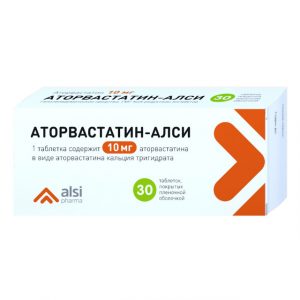Description
Pharmacological action of
rosuvastatin
The maximum concentration of rosuvastatin in blood plasma is reached approximately 5 hours after oral administration. Absolute bioavailability is about 20%. Rosuvastatin is absorbed mainly by the liver, where the main synthesis of cholesterol and excretion of LDL-C occurs. The volume of distribution of rosuvastatin is approximately 134 liters. About 90% of rosuvastatin binds to plasma proteins, primarily albumin. Rosuvastatin is slightly metabolized (about 10%). Rosuvastatin is a non-core substrate for isoenzymes of the cytochrome P450 system. The main enzyme involved in the metabolism of rosuvastatin is CYP2C9. The enzymes CYP2C19, CYP3A4 and CYP2D6 are less involved in metabolism. The main derivatives of rosuvastatin are the N-desmethyl metabolite and lactone metabolites. N-desmethyl is approximately 50% less active than rosuvastatin, lactone derivatives are pharmacologically inactive. Rosuvastatin suppresses the activity of more than 90% of circulating HMG-CoA reductase. About 90% of the dose of rosuvastatin is excreted unchanged with feces (including absorbed and not absorbed rosuvastatin). The rest of the dose is excreted in the urine. About 5% of the dose is excreted in the urine in an unchanged state. The half-life of the drug from blood plasma is approximately 19 hours. The half-life does not change with an increase in the dose of the drug. The geometric mean plasma clearance is approximately 50 liters / hour (coefficient of variation 21.7%). Similar to other HMG-CoA reductase inhibitors, in the process of hepatic uptake of rosuvastatin, a membrane protein carrier of organic anions of type C (OATP-C) is involved, which plays an important role in the hepatic elimination of rosuvastatin. The systemic bioavailability of rosuvastatin increases in proportion to the dose. When using the drug several times a day, the pharmacokinetic parameters do not change.
Special patient groups
Age and gender: No clinically significant effect of age and gender on the pharmacokinetic properties of rosuvastatin has been observed. The pharmacokinetics of rosuvastatin when used in children and adolescents with familial heterozygous hypercholesterolemia was similar to the pharmacokinetics of adult patients.
Race: Pharmacokinetic studies indicate that, compared with people of the Caucasian race, in persons of the Asian race (Japanese, Chinese, Filipinos, Vietnamese and Koreans), the average area under the concentration-time curve (area under the curve, AUC) and the maximum concentration of the drug in blood plasma (Cmax) are approximately 2 times higher. In Indians, these indicators are approximately 1.3 times higher than in those of the Caucasian race. An analysis of population pharmacokinetics did not reveal clinically significant differences in the pharmacokinetic parameters of rosuvastatin between Caucasian and Negroid individuals.
Patients with impaired renal function. Mild or moderate renal impairment did not affect the plasma concentration of rosuvastatin or N-desmethyl metabolite. In patients with severe impaired renal function (creatinine clearance <30 ml / min), the concentration of rosuvastatin and N-desmethyl metabolite was, respectively, 3 and 9 times higher. than in healthy patients. In patients receiving hemodialysis sessions, the plasma concentration of rosuvastatin in equilibrium was 50% higher than in healthy patients. Patients with liver failure: Patients with liver failure of varying severity did not have data on increased exposure to rosuvastatin in individuals with a value of less than 7 on the Child-Pugh scale. However, in 2 participants with values ² ¹ ² ¹of 8 and 9 on the Child-Pugh scale, an increase in the systemic effect of rosuvastatin was observed, at least 2-fold, compared with participants with lower values ² ¹ ² ¹on the Child-Pugh scale. There is no experience with the use of rosuvastatin in individuals with a value of more than 9 points on the Child-Pugh scale. Genetic polymorphism. The transport proteins OATP1B1 and BCRP are involved in the excretion of inhibitors of HMG-CoA reductase, including rosuvastatin. Patients with genetic polymorphism SLCO1B1 (OATP1B1) and / or ABCG2 (BCRP) are at risk for increased exposure to rosuvastatin. Individual polymorphism SLCO1B1 c.521CC and ABCG2 c.421AA are characterized by an increase in exposure (AUC) of rosuvastatin 1.7 times and 2.4 times, respectively, compared with the genotypes SLCO1B1 c.521TT and ABCG2 c.421CC. Pediatric patients. The pharmacokinetics of rosuvastatin in children of 10-17 years old with heterozygous hereditary hypercholesterolemia are not fully characterized. A small study of the pharmacokinetics of rosuvastatin in 18 children showed that the effect of rosuvastatin in pediatric patients appears to be similar to that in adults. In addition, the results of the study show that significant deviations from dose dependence are not expected. Ezetimibe After oral administration, ezetimibe is rapidly absorbed and substantially conjugated to form a pharmacologically active phenolic glucuronide – ezetimibe glucuronide. Average values ² ¹ ² ¹of the maximum concentration of ezetimibe in plasma (Cmax) are observed 1 ² 2 hours and 4 ² 12 hours after ingestion, respectively, for ezetimibe glucuronide and ezetimibe. The absolute bioavailability of ezetimibe cannot be determined, since it is practically insoluble in aqueous media suitable for injection. Concurrent ingestion of food (high and low fat) does not affect the bioavailability of ezetimibe after oral administration. Ezetimibe can be taken without regard to meals. The binding of ezetimibe and its glucuronide to plasma proteins is 99.7% and 88 ² 92%, respectively. Ezetimibe metabolism occurs predominantly in the small intestine and in the liver through glucuronidation (phase II reaction) and subsequent excretion with bile. In all studied species, a minimally expressed oxidative metabolism of ezetimibe was noted (phase I reaction). Ezetimibe and ezetimibe-glucuronide, the main derivatives of the drug, account for 10-20% and 80-90% of the total content of the drug in blood plasma, respectively. Ezetimibe and ezetimibe-glucuronide are slowly eliminated from the blood plasma during intestinal-hepatic recirculation. The half-life of ezetimibe and ezetimibe-glucuronide is about 22 hours. Special patient groups Age and gender of patients: In patients older than 65 years, the concentration of total ezetimibe in the blood plasma is approximately 2 times higher than in patients aged 18-45 years. The decrease in LDL-C and safety profiles in elderly and younger patients taking ezetimibe are approximately the same. Therefore, dose adjustment for elderly patients is not required. The total concentration of ezetimibe is approximately 20% higher in women than in men. The level of lowering LDL-C and safety profiles are approximately the same in men and women taking ezetimibe. Therefore, gender is not a reason for dose adjustment. Patients with renal failure: After a single oral administration of ezetimibe 10 mg in patients with severe renal insufficiency (CC> 30 ml / min), the average AUC increased by 1.5 times compared with healthy participants. This result is not considered clinically significant. For patients with impaired renal function, dose adjustment is not required. In this study, in one patient (undergoing kidney transplantation, receiving various drugs, including cyclosporine), the total effect of all forms of ezetimibe was increased 12 times.
Patients with liver failure: After a single dose of 10 mg of ezetimibe, the average AUC for all forms of ezetimibe was approximately 1.7 times higher than in patients with mild liver failure (5-6 points on the Child-Pugh scale) compared with healthy participants. In a 14-day study with daily intake of ezetimibe at a dose of 10 mg / day in patients with moderate hepatic insufficiency (7 ² 9 points on the Child-Pugh scale), the average AUC for all forms of ezetimibe was approximately 4 times higher than in healthy subjects (on the 1st and 14th day of the study). In patients with mild liver failure, dose adjustment is not required. Due to the unknown effects of increased exposure to ezetimibe in patients with moderate or significant hepatic insufficiency (> 9 points on the Child-Pugh scale), the use of ezetimibe in these patients is not recommended.
Pediatric patients. The absorption and metabolism of ezetimibe are similar in children, adolescents (10 ² 18 years old), and in adults. Based on data for the total content of ezetimibe, it can be concluded that there are no differences in pharmacokinetics between adults and adolescents. There are no pharmacokinetic data for children under 10 years of age. Clinical experience with the drug in children and adolescents includes patients with homo- or heterozygous familial hypercholesterolemia or sitosterolemia.
Combination therapy with rosuvastatin and ezetimibe
Combined use of 10 mg of rosuvastatin and 10 mg of ezetimibe resulted in a 1.2-fold increase in AUC of rosuvastatin (in patients with hypercholesterolemia). The pharmacodynamic interaction between rosuvastatin and ezetimibe cannot be ruled out with regard to adverse effects.
Indications
Treatment of primary hypercholesterolemia in adults (as a supplement to the diet):
– with insufficient control of the disease with monotherapy with rosuvastatin or
– as replacement therapy in patients with sufficient control of the disease while taking both separate substances in the same doses, as a fixed combination.
Composition
1 caps. contains: Active substances: rosuvastatin (in the form of rosuvastatin zinc) – 10 mg, ezetimibe – 10 mg.
Excipients: microcrystalline cellulose, anhydrous colloidal silicon dioxide, magnesium stearate, povidone, croscarmellose sodium, mannitol, sodium lauryl sulfate, low substitution hydroxypropyl cellulose, yellow iron oxide (E172), titanium dioxide (E171), yellow.
Dosage and administration
The drug is used strictly as directed by a doctor!
Rosulip Plus should be taken orally at the same time of the day, regardless of the meal. The capsule should be swallowed whole and washed down with water.
Before and during the entire course of Rosulip Plus therapy, the patient should follow a standard low-cholesterol diet. The dose of the drug should be selected individually based on the target lipid levels, depending on the goals of therapy and the response to treatment.
Combined treatment should only begin after determining the required dosage of rosuvastatin or both components of the drug. Dosage should also take into account the risk of adverse reactions. Dose adjustment can be carried out after 4 weeks of therapy.
The recommended daily dose is one capsule, taken without regard to food. Rosulip Plus is not suitable as a first-line lipid-lowering therapy.
Rosulip Plus Capsules 10 mg / 10 mg and 20 mg / 10 mg are not suitable for the treatment of patients who require a dose of 40 mg of rosuvastatin.
Rosulip Plus should be taken for 2 hours before or 4 hours after taking a sequestrant of bile acids.
Pediatric Patients
Safety and efficacy of Rosulip Plus in individuals under 18 years of age not established.
Elderly patients
In patients older than 70 years, the recommended starting dose of rosuvastatin is 5 mg. This combination of drugs is not suitable as a first-line therapy. Combination therapy should be started only after selecting the appropriate dose of rosuvastatin or both components.
Patients with renal failure
Dose adjustment is not required in patients with mild or moderate impaired renal function. In patients with moderate impaired renal function (creatinine clearance <60 ml / min), it is recommended to start taking rosuvastatin with a dose of 5 mg. A fixed dose combination is not suitable as a first-line therapy. Combination treatment should begin only after selecting the appropriate dose of rosuvastatin or both components. The use of any dose of rosuvastatin in patients with severe impaired renal function is contraindicated. Patients with hepatic insufficiency In patients with mild hepatic impairment (5-6 points on the Child-Pugh scale), dose adjustment is not required. Rosulip Plus is not recommended for patients with moderate (7 9 Child-Pugh score) or severe impaired liver function (> 9 Child-Pugh score). Rosulip Plus is contraindicated in patients with acute liver disease.
Race
In patients of the Asian race, increased systemic exposure to rosuvastatin was noted. In patients of Asian origin, the recommended initial dose of rosuvastatin is 5 mg. A fixed dose combination is not suitable as a first-line therapy. Combination treatment should begin only after selecting the appropriate dose of rosuvastatin or both components.
Genetic polymorphism
Some types of gene polymorphism increase the systemic effects of rosuvastatin. In patients with an established presence of certain types of polymorphism, a lower daily dose of Rosulip Plus is recommended.
Patients predisposed to myopathy
Recommended starting dose of rosuvastatin in patients predisposed to myopathy is 5 mg. A fixed dose combination is not suitable as a first-line therapy. Combination treatment should begin only after selecting the appropriate dose of rosuvastatin or both components.
Concomitant therapy with other drugs
Rosuvastatin is a substrate of various transporter proteins (OATP1B1 and BCRP). The risk of developing myopathy (including rhabdomyolysis) increases with the simultaneous use of Rosulip Plus with some drugs that can increase the concentration of rosuvastatin in plasma as a result of interaction with the aforementioned transport proteins (for example, cyclosporine, as well as some protease inhibitors, including the combination of ritonavir with atazanovir, lopinavir and / or tipranavir). If possible, alternative drugs should be taken, and if necessary, consider the possibility of temporary cancellation of Rosulip Plus. In cases where the combined use of such drugs and Rosulip Plus is unavoidable, the benefits and risks associated with combined treatment and a change in the dose of rosuvastatin should be carefully considered.
Side effects
Adverse reactions observed with rosuvastatin are usually transient and have a slight severity. In controlled clinical trials, the discontinuation rate of rosuvastatin due to adverse events was less than 4%.
In clinical studies lasting up to 112 weeks, 2396 patients took ezetimibe 10 mg / day as monotherapy, 11 308 in combination with statin and 185 in combination with fenofibrate. Adverse reactions were usually transient and of minor severity. The overall incidence of side effects was similar in the ezetimibe and placebo groups. The frequency of withdrawal due to adverse events was comparable in the ezetimibe and placebo groups.
According to reports, 1,200 patients took a combination of rosuvastatin and ezetimibe in clinical trials. According to published data, the adverse effects associated with the use of this combination of drugs in patients with hypercholesterolemia include an increase in liver transaminases, gastrointestinal disturbances, and muscle pain. It is known that both rosuvastatin and ezetimibe can cause these adverse effects. However, the pharmacodynamic interaction between rosuvastatin and ezetimibe cannot be ruled out with regard to adverse effects.
Determination of the frequency of adverse events:
very often ( 1/10), often ( 1/100, but <1/10), infrequently ( 1/1000, but <1/100), rarely ( 1/10 000, but <1/1000), very rarely (<1/10 000), unknown (cannot be estimated based on available data). Often Infrequently Rarely Very rarely Unknown On the part of the hematopoietic system thrombocytopenia2 thrombocytopenia5 On the part of the immune system hypersensitivity reactions, including Quincke’s disease2 hypersensitivity (including painful skin, ) 5 From the endocrine system diabetes 1, 2 From the metabolism decreased appetite3 From the nervous system headache2.4, dizziness2 paresthesia4 polyneuropathy2, memory loss2 peripheral neuropathy2 sleep disorders (including insomnia and nightmares) 2 dizziness5 paresthesia5 Mental disorders depression2, 5 On the part of the cardiovascular system hot flashes3 arterial hypertension3 On the part of the respiratory system cough cough2, shortness of breath 2.5 On the part of the digestive system constipation2 nausea3 pain mouth4 gastritis4 pancreatitis2 diarrhea2 pancreatitis5 constipation5 From the liver and biliary tract increased ALT and / or AST4 increased ALT and / or AST3 increased blood CPK3 increased GGT3 biochemical deviations indicators of liver function3 increased hepatic transaminases2 jaundice2, hepatitis2 hepatitis5, cholelithiasis5, cholecystitis5 From the skin and subcutaneous tissues skin itching2.4, skin rash 2.4, urticaria 2.4 Stevens-Johnson syndrome2, erythema multiforme5 From the musculoskeletal system myalgia2,4 arthralgia3 muscle cramps3 neck pain3 back pain4 muscle weakness4 pain in the extremities4 myopathy and myositis2 rhabdomyolysis2 arthralgia myalgia5 myopathy and rhabdomyolysis5 From the urinary system hematuria2 From the reproductive system and mammary gland gynecomastia2 General reactions asthenia2 fatigue3 b l chest kletke3 bol3 asteniya4 peripheral oteki4 otek2 asteniya5 1While rosuvastatin receiving frequency depends on the presence or absence of risk factors (fasting glucose 5.6 mmol / L, BMI> 30 kg / m2, increased triglycerides, history of hypertension).
2Profile of adverse reactions of rosuvastatin, based on data from clinical studies and widespread post-registration use.
3 Ezetimibe monotherapy. Adverse reactions observed in patients taking ezetimibe (n = 2396), and with a greater frequency than with placebo (n = 1159).
4Ezetimibe when taken with statin. Adverse reactions observed in patients taking ezetimibe and statin (n = 11 308), and with a greater frequency than when taking statin alone (n = 9361).
5 Additional adverse reactions observed with post-registration use of ezetimibe. Since these adverse events were identified on the basis of spontaneous messages, the frequency of these events is not known and cannot be calculated.
As with other HMG-CoA reductase inhibitors, the incidence of adverse drug reactions tends to be dose-dependent.
From the urinary system:
in patients treated with rosuvastatin, proteinuria was observed (determined by the rapid method), which was predominantly tubular in nature. A change in proteinuria with – / traces initially up to ++ and more was observed in 1% of patients at any given time when taken in doses of 10 mg and 20 mg and in about 3% of patients when taken in a dose of 40 mg. When taken at a dose of 20 mg, there was a slight increase in degree + proteinuria with an initial level of proteinuria – / traces. In most cases, proteinuria on its own passed or decreased with continued therapy. When analyzing data from clinical trials and the post-registration use of the drug, no causal relationship between proteinuria and acute or progressive kidney disease has been identified to date. In patients treated with rosuvastatin,
hematuria was noted according to clinical studies, the frequency of this phenomenon is low.
From the musculoskeletal system:
in patients receiving rosuvastatin in all doses, especially at doses> 20 mg, an effect on skeletal muscles, for example, myalgia, myopathy (including myositis), and, in rare cases, rhabdomyolysis, with the development of acute renal failure or without it. In patients taking rosuvastatin, a dose-dependent increase in CPK was also noted. Most of these cases were mild – asymptomatic and transient. In case of increase in KFK (> 5 VGN) treatment should be interrupted.
From the liver and biliary tract:
, as with other HMG-CoA reductase inhibitors, a small number of patients taking rosuvastatin showed a dose-dependent increase in transaminases. Most of these cases were mild – asymptomatic and transient.
The frequency of reports of rhabdomyolysis, serious liver disorders (mainly an increase in hepatic transaminases) and kidneys is higher with 40 mg of rosuvastatin.
When using some statins, the following adverse events are possible:
sexual dysfunction
in exceptional cases – interstitial lung disease.
On the part of laboratory indicators:
in controlled clinical trials of monotherapy, the incidence of a clinically significant increase in serum transaminases (ALT and / or AST 3 VGN) was similar in the ezetimibe (0.5%) and placebo (0.3%) groups. In studies of combination drugs, the increase rate was 1.3% in patients taking ezetimibe + statin, and 0.4% in patients taking statin only. These episodes of elevation were usually asymptomatic, not associated with cholestasis, and transaminase values ² ¹ ² ¹returned to baseline after discontinuation of treatment or against ongoing treatment.
In clinical trials, an increase in CK> 10 VGN was observed in 4 of 1674 (0.2%) patients taking only ezetimibe, in 1 of 786 (0.1%) patients taking placebo, in 1 of 917 patients (0.1%) taking ezetimibe + statin, and in 4 of 929 patients (0.4%), taking only statin. Compared to the corresponding control group (placebo or statin monotherapy), ezetimibe was not associated with an increase in the incidence of myopathy or rhabdomyolysis.
Pediatric Patients
Safety and efficacy of Rosulip ® Plus in individuals under 18 years of age not established.
Rosuvastatin:
in a 52-week clinical study of rosuvastatin, episodes of increased CPK> 10 VGN and symptoms of muscle tissue after exercise or increased activity were more often observed in children and adolescents compared with the frequency in adult patients. Otherwise, the safety profile of rosuvastatin in children and adolescents was similar to that in adults.
ezetimibe:
in a study involving adolescents (10-17 years old) with heterozygous familial hypercholesterolemia (n = 248), episodes of increased ALT and / or AST ( 3 VGN) were noted in 3% of patients (4 people) taking ezetimibe and simvastatin, compared with 2% (2 people) in the simvastatin monotherapy group. As for the increase in KFK 10 VGN, these values ² ¹ ² ¹were, respectively, 2% (2 people) and 0%. No cases of myopathy were noted. This study was not suitable for comparing rare adverse drug reactions.
Storage conditions
The drug should be stored out of the reach of children at a temperature not exceeding 30 ° C.
Expiration
3 years.
Unused drug or waste should be disposed of in accordance with local regulations.
Prescription conditions
pharmacy Prescription
Dosage form
capsules
